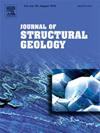Coseismic surface deformation and source mechanism of the 2023 Ms 6.2 Jishishan earthquake, northeastern Tibetan Plateau
IF 2.6
2区 地球科学
Q2 GEOSCIENCES, MULTIDISCIPLINARY
引用次数: 0
Abstract
On 18 December 2023, the Ms 6.2 Jishishan earthquake struck the border region of Gansu province and Qinghai province in the northeastern Tibetan Plateau in China. Field investigations revealed that the 2023 Ms 6.2 Jishishan earthquake produced a ∼1.2-km-long coseismic surface deformation zone with the characteristic centimeter-sized uplift and bulge in the range of 1–13 cm (generally<5 cm), which was mainly restricted to a narrow corridor of 40–50 m in width along an previously-unknown frontal blind fault of the North Lajishan thrust fault zone. In spatial location, the coseismic surface deformation zone corresponds to the core of a late Cenozoic anticline on the hanging wall of blind fault, indicating that the coseismic surface uplift was constrained by the pre-existing tectonic environment.
The North Lajishan thrust fault zone is composed of the west branch fault (F1), east branch fault (F2) and the frontal blind fault (F3), the surveying results document that only the frontal thrust fault (F3) is the Holocene seismically active fault. Thus, the seismogenic fault of the 2023 Ms 6.2 Jishishan earthquake was suggested to be the F3 fault, indicating the northeastward propagation and expansion of the most recent earthquake activities within the North Lajishan thrust fault zone related to the ongoing northeastward shortening of the northeastern Tibetan Plateau accommodating the Eurasia-India continental collision.
青藏高原东北部 2023 年 Ms 6.2 级积石山地震的同震地表变形与震源机制
2023 年 12 月 18 日,中国青藏高原东北部甘肃省和青海省交界地区发生了 Ms 6.2 级积石山地震。实地调查显示,2023 年鸡足山 6.2 级地震产生了一条长约 1.2 公里的共震地表变形带,该变形带具有厘米级的隆起和隆起特征,隆起和隆起的范围为 1-13 厘米(一般为 5 厘米),主要局限于北腊子山推断断裂带的一条以前未知的正面盲断层上,宽度为 40-50 米的狭窄走廊内。北腊子山推断断裂带由西支断层(F1)、东支断层(F2)和正面盲断层(F3)组成,勘测结果表明,只有正面推断断层(F3)是全新世地震活动断层。因此,2023 年 Ms 6.2 积石山地震的发震断层被认为是 F3 断层,这表明最近的地震活动在北拉吉山推断 断层带内向东北传播和扩展,这与青藏高原东北部因欧亚大陆-印度大陆碰撞而不断向 东北缩短有关。
本文章由计算机程序翻译,如有差异,请以英文原文为准。
求助全文
约1分钟内获得全文
求助全文
来源期刊

Journal of Structural Geology
地学-地球科学综合
CiteScore
6.00
自引率
19.40%
发文量
192
审稿时长
15.7 weeks
期刊介绍:
The Journal of Structural Geology publishes process-oriented investigations about structural geology using appropriate combinations of analog and digital field data, seismic reflection data, satellite-derived data, geometric analysis, kinematic analysis, laboratory experiments, computer visualizations, and analogue or numerical modelling on all scales. Contributions are encouraged to draw perspectives from rheology, rock mechanics, geophysics,metamorphism, sedimentology, petroleum geology, economic geology, geodynamics, planetary geology, tectonics and neotectonics to provide a more powerful understanding of deformation processes and systems. Given the visual nature of the discipline, supplementary materials that portray the data and analysis in 3-D or quasi 3-D manners, including the use of videos, and/or graphical abstracts can significantly strengthen the impact of contributions.
 求助内容:
求助内容: 应助结果提醒方式:
应助结果提醒方式:


